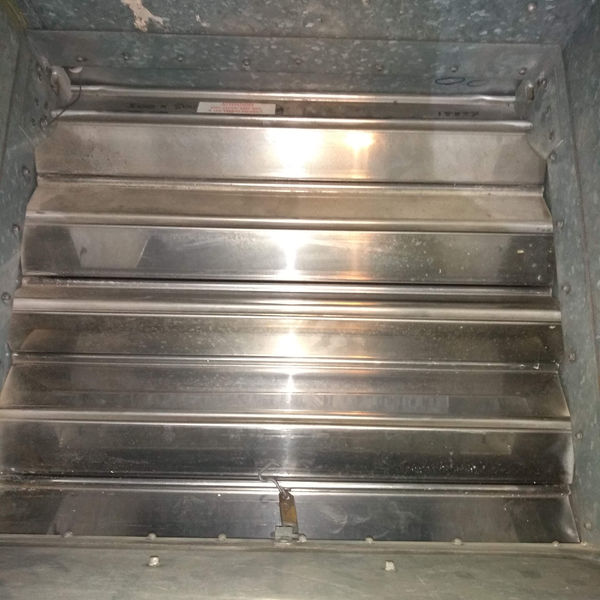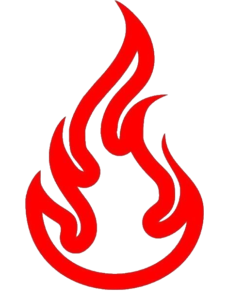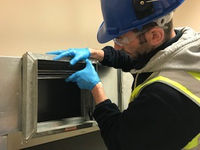
Request A Call Back
Fire dampers form a crucial part of a building’s safety and fire prevention system. In addition to being a legal requirement, they are necessary for compliance with your insurance provider.
Regular duct cleaning, maintenance, and testing are also required to remain compliant. Below, we have listed the most common questions and answers to help those responsible for premises understand more about fire damper testing.

What is a Fire Damper?
Fire dampers are mechanisms located in ducts where they pass through fire walls and fire-rated floors. They are designed to close automatically in the event of a fire. Without functioning fire dampers, fire barriers become ineffective, making it crucial to keep them fully operational for fire safety.
According to BS 9999:2017, the Code of Practice for Fire Safety in the Design, Management, and Use of Buildings, a fire damper is defined as a movable closure within the ductwork that operates automatically or manually to prevent the passage of fire.
Typically, fire dampers are installed inside ductwork where it passes between fire-rated walls and floors.
What is a Fire Damper Drop Test?
A fire damper drop test is conducted to verify the operation of a fire damper. It is called a drop test because, during the test, the fire damper should drop to the closed position.
When in the closed or dropped position, fire dampers help reduce the spread of fire and smoke, thereby minimising property damage and saving lives.
As fats, oils, and grease from fryers travel through extraction ducts, fire dampers can become clogged, causing them to jam or stick in the raised open position. Fire dampers should be inspected and, if necessary, cleaned annually as part of a scheduled maintenance plan, which we provide as part of our Aftercare package.
*Please note: Fire dampers are not typically found in kitchen extract systems. They may occasionally be installed in older or non-compliant kitchen extract systems.

Who can Test Fire Dampers?
It is a legal requirement to have your fire dampers inspected and tested annually according to BS 9999:2017. The regulations state that testing must be carried out by a competent person.
To be deemed competent, we recommend that the person should be properly trained and perform testing as part of a planned maintenance schedule, recording the tests and, wherever possible, using photographs as evidence of compliance.
What Qualifications do I need to Test Fire Dampers?
According to ACoP5 (41, 42, 43), The Regulatory (Fire Safety) Order 2005 and the Fire Scotland Act 2005 the testing of Fire Dampers must be carried out by a competent person. The definition of a competent person according to the HSE:
“A competent person is someone who has sufficient training and experience or knowledge and other qualities that allow them to assist you properly. The level of competence required will depend on the complexity of the situation and the particular help you need.“
We therefore recommend that individuals performing fire damper testing should have completed fire damper training within the last three years and have conducted fire damper testing throughout that period.
Both the training and experience should be documented and recorded.
What is the difference between a Fire Damper and a Fire Smoke Damper?
A fire damper is designed to limit the spread of fire, while a smoke damper is designed to limit the spread of smoke. Fire dampers are triggered by the presence of heat, and smoke dampers are triggered by the presence of smoke.
Since smoke travels faster than fire, if ductwork only has fire dampers fitted, smoke can travel through the duct before the fire damper is activated, causing damage to property and endangering people.
How do you Reset a Fire Damper?
To reset a fire damper, you must follow the manufacturer’s instructions. However, most fire dampers are spring-loaded and held under compression with a simple hook attached to a fire damper link.
This link melts under heat, allowing the fire damper to drop or close shut. To reset it, close the mechanism (which may require a jack-type tool to compress the spring mechanism) and attach the hook to the link to retain the mechanism in position.
Please note: Fire dampers vary, and you should always consult and follow the manufacturer’s guidelines.
What records should I keep for Fire Damper Testing?
To ensure compliance, property owners must maintain up-to-date and accurate records of all cleaning, maintenance, repair work, and testing of fire dampers. These records should, where possible, include photographic evidence of all work carried out.
Why do Fire Dampers Fail Testing?
Fire Dampers can fail testing for many reasons, however, the most common problems are related to the mechanism closing. This can be due to:
- Mechanical failure, corrosion
- Build up of grease, dust or debris that inhibits the mechanism from closing and creating a seal
- Installed incorrectly (blades must be at the top)
- Transit tape still in place following installation
- Missing fusible link
- Insufficient access to test
- Twisted springs
- Obstructions
Our Easy 4 Step Process
Get Clean, Safe & Compliant
1. Contact Us
Call us now to speak with one of our cleaning experts today.
- Speak to an Expert
- Fast Response
- Nationwide Service
2. Site Visit
We’ll meet with you on site to inspect the facility & review your options.
- Site Inspection
- Risk Assessment
- Dedicated Account Managers
3. Get Clean
Get perfectly clean & compliant with our certified engineers.
- Minimise Disruption
- All work Certified
- Perfectly Clean
4. Aftercare
Stay clean & compliant, even after our service!
- Be Compliant
- Insurance Approved
- Planned Maintenance Schedule

